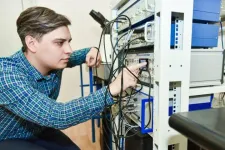(Press-News.org) BROOKLYN, New York, Monday, February 8, 2021 -- A holy grail for orthopedic research is a method for not only creating artificial bone tissue that precisely matches the real thing, but does so in such microscopic detail that it includes tiny structures potentially important for stem cell differentiation, which is key to bone regeneration.
Researchers at the NYU Tandon School of Engineering and New York Stem Cell Foundation Research Institute (NYSF) have taken a major step by creating the exact replica of a bone using a system that pairs biothermal imaging with a heated "nano-chisel." In a study, "Cost and Time Effective Lithography of Reusable Millimeter Size Bone Tissue Replicas with Sub-15 nm Feature Size on a Biocompatible Polymer," which appears in the journal Advanced Functional Materials, the investigators detail a system allowing them to sculpt, in a biocompatible material, the exact structure of the bone tissue, with features smaller than the size of a single protein -- a billion times smaller than a meter. This platform, called, bio-thermal scanning probe lithography (bio-tSPL), takes a "photograph" of the bone tissue, and then uses the photograph to produce a bona-fide replica of it.
The team, led by Elisa Riedo, professor of chemical and biomolecular engineering at NYU Tandon, and Giuseppe Maria de Peppo, a Ralph Lauren Senior Principal Investigator at the NYSF, demonstrated that it is possible to scale up bio-tSPL to produce bone replicas on a size meaningful for biomedical studies and applications, at an affordable cost. These bone replicas support the growth of bone cells derived from a patient's own stem cells, creating the possibility of pioneering new stem cell applications with broad research and therapeutic potential. This technology could revolutionize drug discovery and result in the development of better orthopedic implants and devices.
The research, "Cost and time effective lithography of reusable millimeter size bone tissue replicas with sub-15 nm feature size on a biocompatible polymer," appears in Advanced Functional Materials.
In the human body, cells live in specific environments that control their behavior and support tissue regeneration via provision of morphological and chemical signals at the molecular scale. In particular, bone stem cells are embedded in a matrix of fibers -- aggregates of collagen molecules, bone proteins, and minerals. The bone hierarchical structure consists of an assembly of micro- and nano- structures, whose complexity has hindered their replication by standard fabrication methods so far.
"tSPL is a powerful nanofabrication method that my lab pioneered a few years ago, and it is at present implemented by using a commercially available instrument, the NanoFrazor," said Riedo. "However, until today, limitations in terms of throughput and biocompatibility of the materials have prevented its use in biological research. We are very excited to have broken these barriers and to have led tSPL into the realm of biomedical applications."
Its time- and cost-effectiveness, as well as the cell compatibility and reusability of the bone replicas, make bio-tSPL an affordable platform for the production of surfaces that perfectly reproduce any biological tissue with unprecedented precision.
"I am excited about the precision achieved using bio-tSPL. Bone-mimetic surfaces, such as the one reproduced in this study, create unique possibilities for understanding cell biology and modeling bone diseases, and for developing more advanced drug screening platforms," said de Peppo. "As a tissue engineer, I am especially excited that this new platform could also help us create more effective orthopedic implants to treat skeletal and maxillofacial defects resulting from injury or disease."
INFORMATION:
The research was supported by the US Army Research Office, the National Science Foundation (CMMI and CBET programs), the Office of Basic Energy Sciences of the US Department of Energy, the New York Stem Cell Foundation, and the Ralph and Ricky Lauren Family Foundation. The NanoFrazor was acquired through an NSF CMMI MRI grant.
About the New York University Tandon School of Engineering
The NYU Tandon School of Engineering dates to 1854, the founding date for both the New York University School of Civil Engineering and Architecture and the Brooklyn Collegiate and Polytechnic Institute. A January 2014 merger created a comprehensive school of education and research in engineering and applied sciences as part of a global university, with close connections to engineering programs at NYU Abu Dhabi and NYU Shanghai. NYU Tandon is rooted in a vibrant tradition of entrepreneurship, intellectual curiosity, and innovative solutions to humanity's most pressing global challenges. Research at Tandon focuses on vital intersections between communications/IT, cybersecurity, and data science/AI/robotics systems and tools and critical areas of society that they influence, including emerging media, health, sustainability, and urban living. We believe diversity is integral to excellence, and are creating a vibrant, inclusive, and equitable environment for all of our students, faculty and staff. For more information, visit engineering.nyu.edu.
A team of researchers from the Laboratory of Biophysics at NUST MISIS, Lomonosov Moscow State University and D. Mendeleev University of Chemical Technology of Russia has summarized metal-containing diagnostic agents for positron emission tomography (PET), magnetic resonance imaging (MRI), and single-photon emission computed tomography (SPECT) imaging of Alzheimer's disease (AD). According to the researchers, metal-containing radiopharmaceuticals are not only highly effective for detecting early markers of Alzheimer's disease, but also synchrotron-independent and ...
Bats are the only mammals that can actively fly. Some species travel over one hundred kilometres on their nocturnal excursions in search of food. Researchers at the Max Planck Institute of Animal Behavior in Radolfzell have now discovered that European free-tailed bats use uplifting winds for their ascents - a behaviour that was previously known only from birds. To do this, they tracked the bats using mini GPS loggers and then linked the flight data to weather data. The animals can thus gain altitude of well over 1,000 metres without expending much energy. The results ...
DNA sequences that can fold into shapes other than the classic double helix tend to have higher mutation rates than other regions in the human genome. New research shows that the elevated mutation rate in these sequences plays a major role in determining regional variation in mutation rates across the genome. Deciphering the patterns and causes of regional variation in mutation rates is important both for understanding evolution and for predicting sites of new mutations that could lead to disease.
A paper describing the research by a team of Penn State scientists is available online in the journal Nucleic Acids Research.
"Most of the time we think about DNA as the classic ...
A 'biological age' score predicts that being male, overweight, a smoker and having depression all contribute to biological aging, a study published today in eLife reports.
Aging can be measured in different ways. While chronological age is measured by date of birth, scientists have developed a range of measurements to determine our biological age. These include measuring the length of telomeres (little caps on the end of our chromosomes that shorten as we grow older), chemical changes to our DNA (epigenetics), and changes to the proteins and metabolites in our bodies ...
According to the Education Act, schools in the ethnically divided Bosnia and Herzegovina must teach students "democratic ideals in a multicultural society." But according to new research from the University of Copenhagen, the opposite happens: Segregated schools perpetuate ethnic divisions between Croats, Serbs and Bosniaks, making reconciliation after the 1992-1995 wars extremely difficult.
25 years ago, the warring factions in the war in former Yugoslavia signed a peace agreement. Bosnia and Herzegovina, where 100,000 people lost their lives during the war, is now an independent state comprising the Bosnian-Croatian Federation and the Republika Srpska. It is a division that ...
Social conflicts, from policy debates to family disagreements, can easily devolve into angry words and personal attacks. Such heated confrontations, however, seldom resolve disagreements and can entrench opposing views.
A better approach to resolving interpersonal disagreements is to embrace characteristics that psychological scientists associate with wisdom, like intellectual humility, diverse viewpoints, and open-mindedness.
But applying these elements of wisdom can be difficult, especially during confrontations. The trick, according to new research published ...
The global problem of unowned domestic cats, driven by the cats' phenomenal reproductive success, carries significant economic, animal welfare and biodiversity costs. Big-data research led by an expert on veterinary medicine and infectious diseases at City University of Hong Kong (CityU) has found that although more than 80% of cats in Australia were desexed, only a fraction have had surgery before reaching puberty, thus creating a "pregnancy gap". To close this gap and prevent unwanted litters, it is recommended that the age of desexing is before four months.
The research was led by Professor ...
OAK BROOK, Ill. - Breast cancer death rates have stopped declining for women in the U.S. younger than age 40, ending a trend that existed from 1987 to 2010, according to a new study in Radiology. Researchers expressed hope that the findings would raise awareness of breast cancer in younger women and spur research into the causes behind the change.
Breast cancer is the most common non-skin cancer and the second most common cause of cancer deaths in women in the U.S., accounting for 30% of all cancers in women. Although most invasive breast cancers occur in women age 40 years and older, ...
Scientific and public health experts have been raising the alarm for decades, imploring public officials to prepare for the inevitability of a viral pandemic. Infectious epidemics seemingly as benign as "the flu" and as deadly as the Ebola virus provided ample warning, yet government officials seemed caught off guard and ill prepared for dealing with COVID-19. Three future-oriented researchers and policy experts map out an "Epidemiological Blueprint for Understanding the Dynamics of a Pandemic."
COVID Detectives
Researchers around the world have become forensic, Sherlock Holmes-like "consulting detectives" for government officials and public health organizations. Handling tens of thousands ...
In the span of only 15 years, a small academic elite has increased its share of academic citations significantly. In the year 2000, 14 per cent of all citations went to the top one percent of the most cited researchers. New research shows that this figure had risen to 21 per cent in 2015.
The people behind these remarkable findings are senior researcher Jens Peter Andersen, Danish Centre for Studies in Research and Research Policy (CFA) at Aarhus BSS, Aarhus University, and associate professor Mathias Wullum Nielsen (former CFA, now University of Copenhagen). Their examination of almost 26 million scientific papers and four million authors has just been published in the well-established interdisciplinary journal Proceedings of the National Academy of Sciences ...






